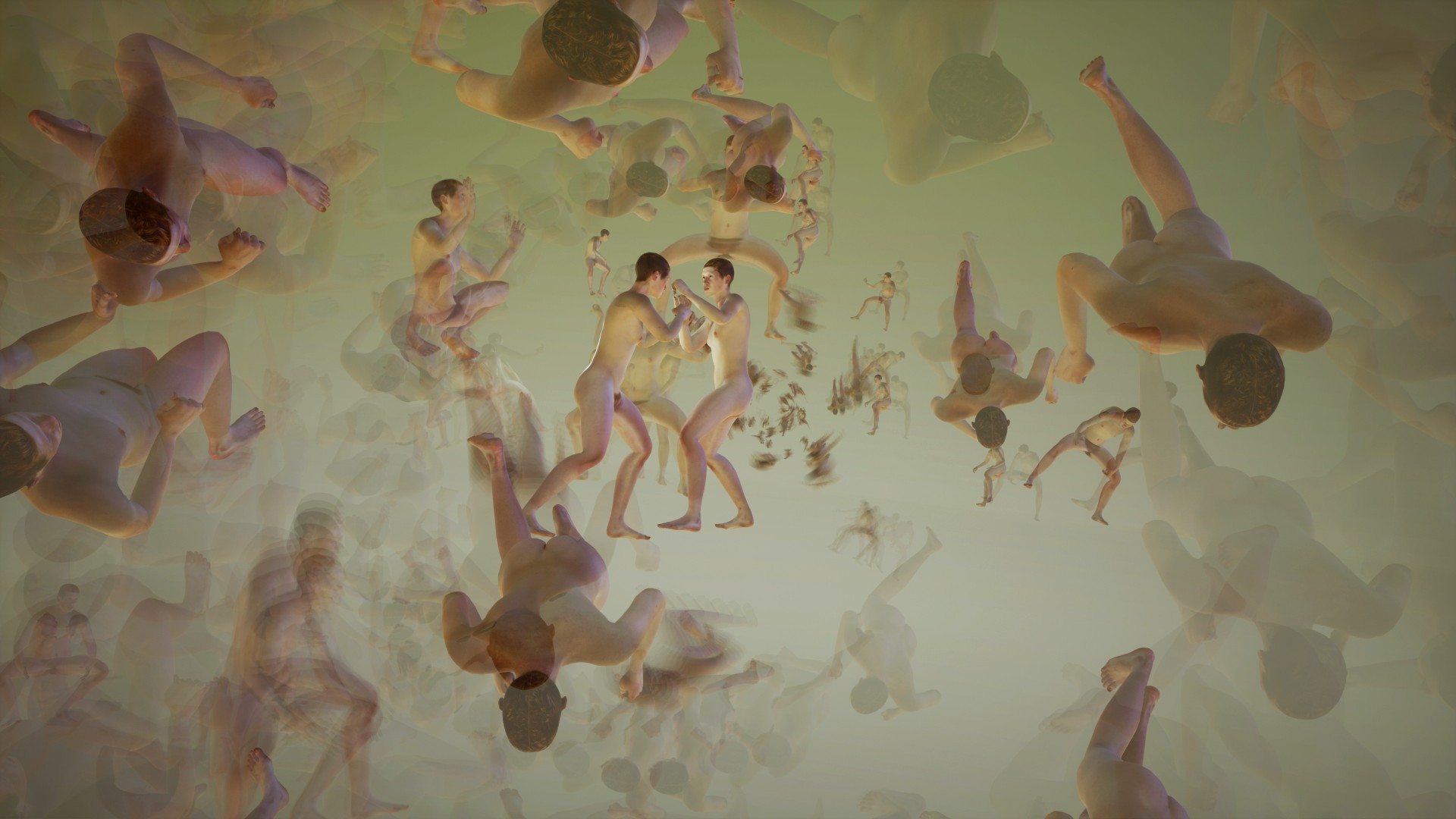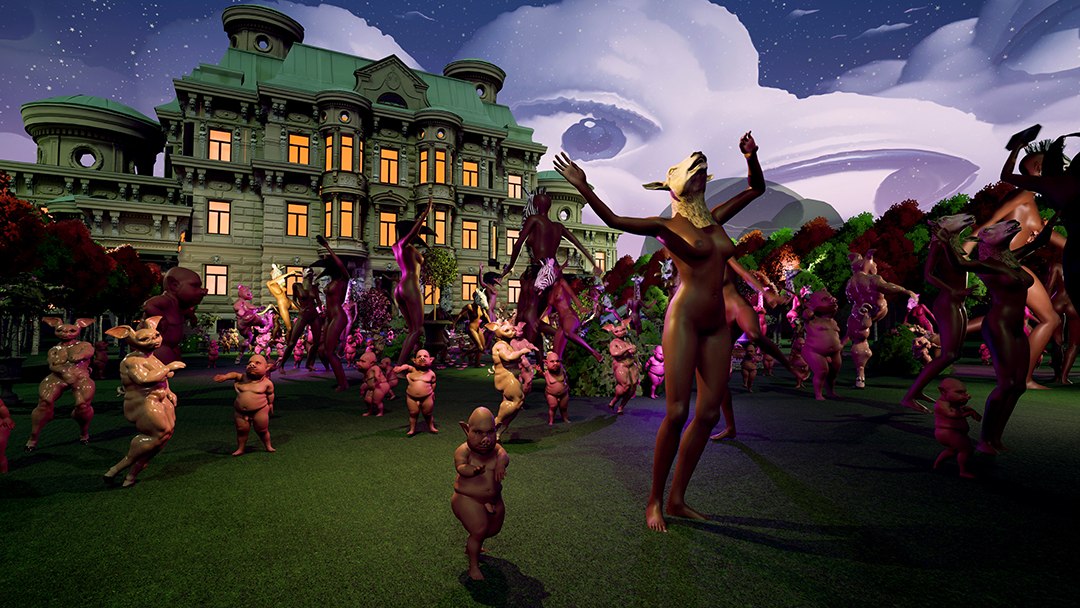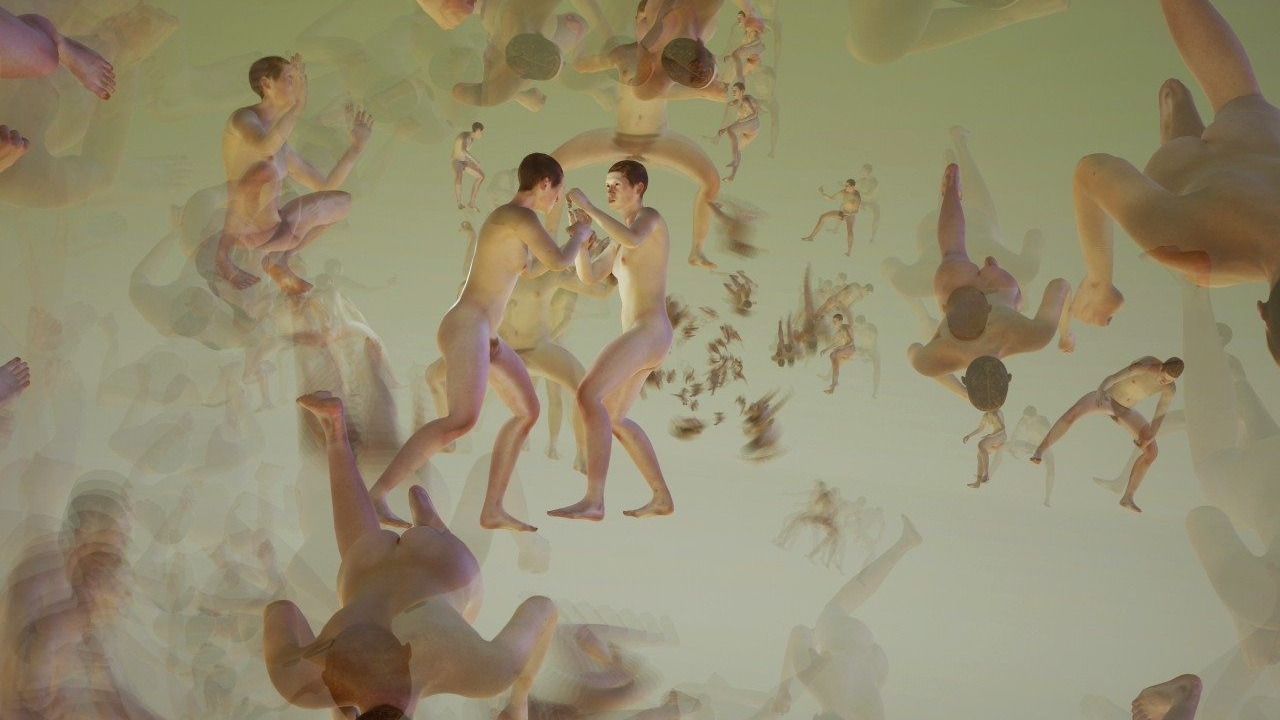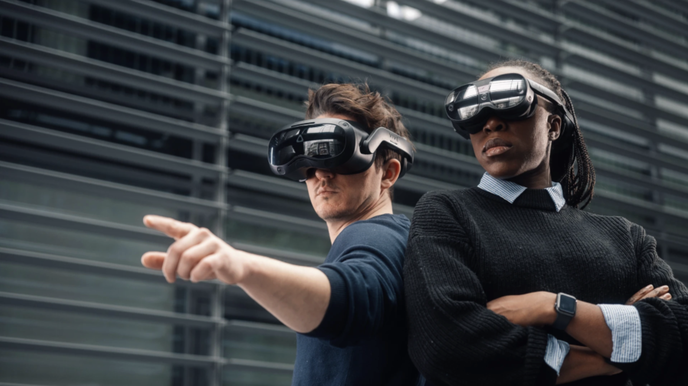When a work evokes such diverse interpretations—leaving critics on Letterboxd both unsettled and deeply moved—it surely merits our attention. Such visceral, polarized reactions suggest it has struck a profound chord. I'm referring to "8 Billion Selves," winner of this year's "VR360 Narrative Award" at the Kaohsiung Film Festival.
Rather than a narrative, this collaboration between Dutch director Tibor De Jong and 3D artist Doris Konings presents a portrait of human civilization's current state—one of excess, chaos, and directionless drift. The experience begins aboard what appears to be a vast industrial vessel at sea. Through a disorienting transition that turns the world on its head, viewers are transported through a series of spaces: an island, an abandoned department store, palace gardens, and a religious sanctuary. These environments are populated by recurring figures—identical naked men whose faces skirt the uncanny valley—and plaza dancers with bestial heads.
Finally, the viewer's vision is consumed by an enormous male head at the center of the sanctuary. In this moment, one realizes how easily a flourishing civilization can vanish—like an old television set switching off, silencing all its tumult and spectacle in an instant. One might expect the creator of such an ambitious, prophetic work to be a tense, high-strung artist. My encounter proved entirely otherwise.
 8 Billion Selves" opens with an army of identical clones engaged in a wrestling match. (Source: KFF)
8 Billion Selves" opens with an army of identical clones engaged in a wrestling match. (Source: KFF)
Reflecting on "Being Human"
"Being human, that's overwhelming in a way." When I began my interview with director Tibor De Jong about the audience's polarized responses, his reply was unexpectedly relaxed. "I understand people are gonna react like that, especially because the story isn't told from A to B. It's more about interpretation, things like that. So I knew that people are going to be confused and overwhelmed, and hopefully they're also going to be entertained, but that fitted quite well with the theme—because I think being human is in a way overwhelming."
The director then introduced his wife, Doris Konings, who realized his vision through 3D artistry. The music was composed by his father, Spinvis, known in the Netherlands for his neo-psychedelic and experimental pop work. "We did all the things together," he explained. "It was very fun to work with people you really know, really trust. I really love working with your wife and your father, and I think that shows through the work—you can really see that we had real fun making it."
 Director Tibor De Jong uses "8 Billion Selves" to explore what it means to be human.
Director Tibor De Jong uses "8 Billion Selves" to explore what it means to be human.
"8 Billion Selves" emerged when the world's 8 billionth person was born. The director explains, "We thought it was the right time to make a retrospective about what it's like to be human. That's a very broad question, yeah, but I think it's the right question, because everyone has an opinion about it—after all, everyone who sees this is human. So if you send people into the experience with that to hold onto, they can always give meaning to the world for them."
The director's matter-of-fact observation about every viewer being human brought a smile to my face—philosophical yet slightly mischievous. Indeed, we rarely consider how we process information through inherently human perspectives, yet we are the only species capable of such self-reflection.
Through its complex visual spectacle, "8 Billion Selves" prompts viewers to contemplate their place among these 8 billion souls. What is my relationship to this vast number? Going further back, to the Primordial soup—where all 8 billion of us originated from a single cell—raises questions about personal identity. Am I truly unique?
When Digital Information Becomes the View of the Outside
This brings us to a note I jotted down after watching "8 Billion Selves": "It's like walking into the Instagram Stories of 8 billion people." In the digital age, "8 Billion Selves" adds another layer to the relationship between individual and collective: social media seems to have brought humanity back to a digital primordial soup, where everyone can monitor each other, their consciousness flowing with big data, collectively responding to the same posts and videos.
While he acknowledged this interpretation, the director remained contemplative. "If I made this work a hundred years ago it would be different, and in a hundred years it would be different as well," he explained. "I'm not particularly against it—it's just the way it is right now."
 "8 Billion Selves" concludes as a colossal head in the sanctuary consumes the viewer's vision. (Source: Nemo Vos)
"8 Billion Selves" concludes as a colossal head in the sanctuary consumes the viewer's vision. (Source: Nemo Vos)
Not giving up, I pressed the director on whether he experiences digital anxiety or addiction. His answer, though different from what I expected, offered a unique perspective: "A big part of my life is experiencing life through the Internet, so for me, it's like watching out of the window." The trees and birds outside can be equated with posts or messages from people across the globe behind computer screens—this dissolution of boundaries perhaps indicates we're already living in the world of "8 Billion Selves."
The beast-headed dancers in the garden plaza of the third act embody a particular metaphor. "Every person has this animalistic side," the director explained. "I think now, in the constant stream of Internet and different kind of consciousness, this side is being fed more. We're constantly triggered to use that side of ourselves more. So they're both horrifying and, in a way, erotic."
The beast-headed figures intentionally blur the line between human and beast, with dance movements that display power and a sense of losing control. Through this visual design, it seems to ask: In the digital age, how will human nature manifest? As we are constantly stimulated by various content in the online world, how will our behavior change?
Our conversation turned to the attention economy. When I shared my observation about "entering 8 billion people's Stories," the director engaged us in a discussion about content consumption. "When we watch longer videos," he noted, "sometimes you remember what you saw. But with short videos, it just streams directly into your brain."
 The fairy-like and beast-headed giant figures dance before you, both awe-inspiring and slightly terrifying. (Source: Nemo Vos)
The fairy-like and beast-headed giant figures dance before you, both awe-inspiring and slightly terrifying. (Source: Nemo Vos)
Presenting Maximalism Through VR
Discussing how long and short videos affect our absorption and thinking, the director didn't express strong disapproval, but rather described a state. So, why did he choose VR to tell this story?
Tibor De Jong explained that he started working with VR about four or five years ago, having previously focused on flat collage art. When he began creating 3D versions of these collages, he thought it would be convenient to view 3D models from all angles with a VR headset. "but why should I use this to make something 2D where I can also just create things for this."
So, he began using Unreal Engine for his creations. "But at first I didn't know how to render out stereoscopic, so I just built the virtual worlds, and then you became the camera, just like in this one. But in a game engine, you can only include a limited number of characters and objects before it becomes too messy. And you've seen my work - it has quite a lot of figures, so it becomes heavy quite quickly."
Here, he used the term "Maximalism" to describe his work—aesthetic that seeks repetition and more elements. "8 Billion Selves," thanks to VR's immersive nature, allows the audience to fully enter this fantasy; through an extreme visual experience, it forces people to think.
Then, the director shared an interesting audience feedback: "Last week. Spoke to a guy he martial art guy and he very timid, very calm and he really liked the minimalist work. And then we put him in the experience." The director's earlier question about what we thought "8 Billion Selves" was about was also mentioned. According to the director, people are able to find their own meaning in the work. The extreme visuals unfold before us, and ultimately, we see what we want to see—that's what it means to be human.
"If shorts weren't invented, maybe the work wouldn't be as maximalist," the director suddenly added at the end of the interview. Like his work, it doesn't offer a one-dimensional critique but presents the current state to you: Look, this is the mental state of 8 billion people.

 8 Billion Selves" opens with an army of identical clones engaged in a wrestling match. (Source: KFF)
8 Billion Selves" opens with an army of identical clones engaged in a wrestling match. (Source: KFF) Director Tibor De Jong uses "8 Billion Selves" to explore what it means to be human.
Director Tibor De Jong uses "8 Billion Selves" to explore what it means to be human. "8 Billion Selves" concludes as a colossal head in the sanctuary consumes the viewer's vision. (Source: Nemo Vos)
"8 Billion Selves" concludes as a colossal head in the sanctuary consumes the viewer's vision. (Source: Nemo Vos) The fairy-like and beast-headed giant figures dance before you, both awe-inspiring and slightly terrifying. (Source: Nemo Vos)
The fairy-like and beast-headed giant figures dance before you, both awe-inspiring and slightly terrifying. (Source: Nemo Vos)
